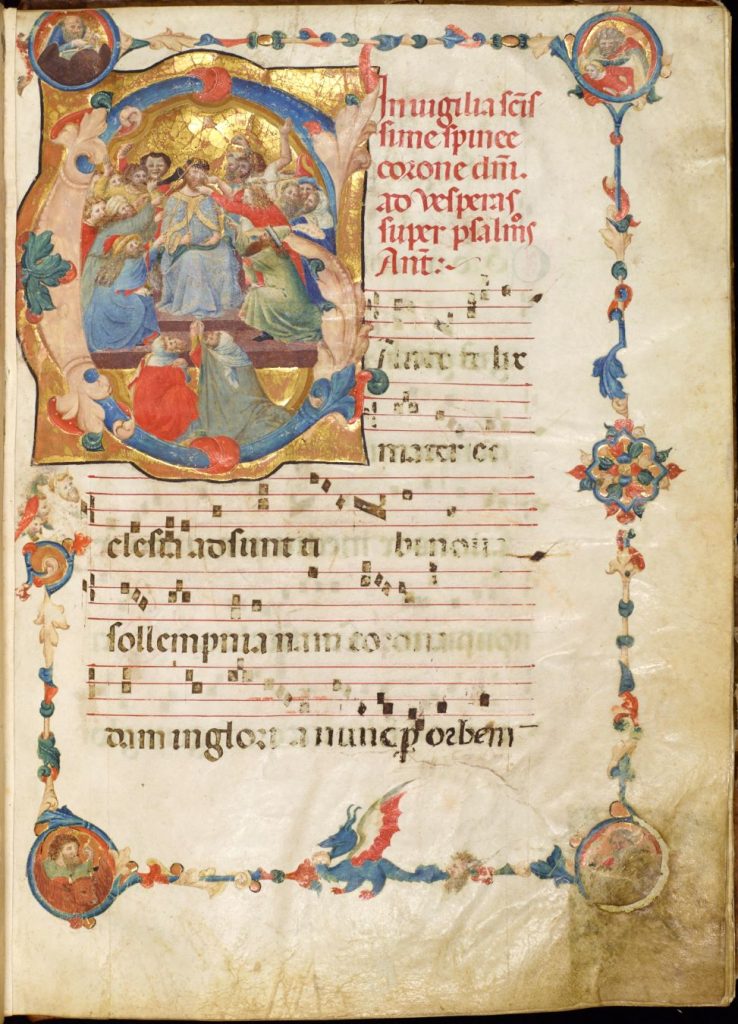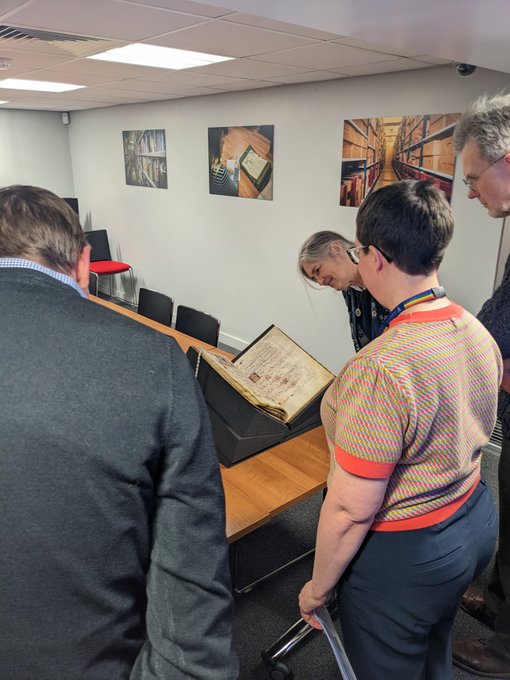University of Liverpool manuscript LUL MS.F.4.13 has been identified as containing the fullest extant form of this Dominican version of the text and music for the Office and Mass of the Feast of the Crown of Thorns.** The manuscript also contains a number of later and contemporary additions – including the Dies irae and the Office and Mass of St. Matthew. The entire thing can be viewed online here.
The illuminations in the first part of the book help to locate and date its production. They have been associated with the school of Francesco Traini (active 1321-1365), and the manuscript is thought to have been made in Pisa, in around 1330. In 1332 a Pisan church, S. Maria del Pontenovo, acquired a single thorn from the Crown of Thorns and consequently changed its name to S. Maria della Spina. It has therefore been deduced that this manuscript was likely made in celebration of this event.

The addition of the Mass of St. Matthew in a 15th century hand has led some to posit that, at some point relatively early in its history, the manuscript may have moved to the monastery of St. Matthew at Pisa – a nearby community of Benedictine nuns.

It seems that the manuscript remained in Pisa for several hundred years thereafter. Its next known provenance can be discerned by screwing one’s eyes up and staring hard at an effaced inscription on the front pastedown:

Clearly legible is a place and date, likely indicating where and when the book was purchased: “Pisa Sept. 1837”. But it is also possible to make out above this the name “Pauline Trevelyan” and beneath “from W.C.T.”. It would seem, then, that the manuscript was purchased by the English naturalist and geologist Walter Calverley Trevelyan (1797-1879) in Pisa in 1837, and presented to his wife, the painter Pauline Trevelyan (1816-1866).
In a further twist in the tale, Pauline Trevelyan was famously a friend of John Ruskin (1819-1900). Ruskin was a great admirer of the Church of Santa Maria della Spina, and drew the church twice – once in 1840 and once in 1845 (Ruskin MP I Notes (lancaster.ac.uk)).
The manuscript was later owned by the printer Charles Weatherby Reynell (1798-1892). It was purchased by the Liverpool bookseller Henry Young at the sale of a selection of books from Reynell’s library conducted by Sotheby’s in 1895. It seems likely that Young then sold the manuscript to Cedric Boult (1853-1950), as it was donated to the University of Liverpool by his son, the conductor Sir Adrian Boult (1889-1983), after his father’s death in 1950.
In February of this year the manuscript was brought to life once more: participants in a workshop on musical manuscripts, run by Professor Lisa Colton, sang sections of the mass, much as its original 14th century owners would have done. The manuscript is also used in classes on codicology and Early Musical Cultures.
*An antiphoner is a bound collection of antiphons – short chants sung as part of a Christian liturgical service.
**The feast of the Crown of Thorns is a feast day of the Roman Catholic Church, celebrated on the Friday after Ash Wednesday.
Further reading:
Maurey, Yossi, The Dominican Office and Mass for the Crown of Thorns, Kitchener: The Institute of Medieval Music, 2019.
Blezzard, J., Ryle, S. and Alexander, J., “New Perspective on the Feast of the Crown of Thorns”, Journal of Plainsong & Medieval Society, 10 (1987), 23-32.

